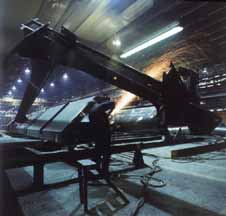
BCE Place: Heritage Square and Galleria
Toronto, Ontario
Santiago Calatrava Architect
Fabrication
 |
BCE Place: Heritage Square and Galleria Toronto, Ontario Santiago Calatrava Architect
Fabrication
|
![]()
The information pertaining to the fabrication process has been taken from the notes of a presentation made by Wayne Baigent of Canron Inc. to the Steel Structures Education Foundation Architectural Educators Meeting in November 1993.
In planning for the fabrication it
was realized that there would be constraints on the geometry and weight of the
pieces. Simply stated, this affected:
1. Handling, this included turning in the shop and egress from the plant.
2. The shipping through the city streets that have both height and width limitations.
3. The access and types of equipment possible on a congested urban site.
4. Constraints imposed by the General Contractor due to problems related to
the orchestration of the project.
The fabricator viewed the steel as a working piece of sculpture. It was recognized that people would be examining and touching the sturcture more closely than normal.
The majority of the joints in the structure are welded. The amount of shop welding was maximized. The pieces were as large as could be handled under tightly controlled shop conditions.
Since the structure was to be painted, the edges would be important. If too sharp, they would tend to sustain wear and damage. For this reason, hot rolled edges were used wherever possible. And for this reason, they chose to use angles and hollow structural steel sections, and if square or rectangular sections were required to be built up from plates, to consider recessing two of the plates to create fillet welds that would require grinding.
Although the structure appears to be light and airy, it is in fact quite rigid. The excessive triangulation means that extreme care must be taken to maintain tight tolerances. Members that do not fit will not be able to be coaxed into place.
The geometry was critical and the computer proved a helpful tool for ascertaining geometry and checks.
Oversized holes and slotted holes that can sometimes be used in bolted connections could not be used. Although they can be good for expansion problems or connections to existing steel, they are counterproductive to an erector. Holes and their spacing must be as exact as possible as this is what sets the structure into its exact position.
|
|
|
|
Top
view of side column during fabrication. |
Fabricator welding the steel capital atop a column for Heritage Square |
|
|
|
|
View
up base of central column for Heritage Square during welding operations |
View of welding of top capital of central column for Heritage Square |
|
|
|
|
Close
up of welding for capital |
Completed column ready for transport to Heritage Square. Note size of man. |
|
|
|
|
Worker
preparing the steel in a jig for a canoe |
Jig setup for canoe construction |
In order to prepare the shop drawings for the structure, the following questions were asked:
1. Look for common elements
2. Look for straight elements -- e.g. boxes or Tees
3. Can they make the box sections to Tees from flats or universal rolled plates
to avoid grinding edges?
4. Can they make box sections with two sides recessed?
5. Can the roof elements be made from HSS?
6. Straight line welding is possible if boxes are built up straight and then
rolled.
7. Are the plates thick enough not to buckle when being welded or rolled?
8. Are there not connections that could be standardized?
9. Where are the best splice locations for the field?
As each department looked more deeply into their areas, the people in the Engineering, Drafting, Plant and Erections departments of Canron made models so that they fully understood what was being built.
The case studies represented in this web document represent a condensed body of work that will be available in extended CD-ROM format from the Steel Structures Education Foundation upon written request.
The images on this site are copyrighted and as such may not be commercially reproduced without written consent of the Steel Structures Education Foundation.
last updated June 3, 2005